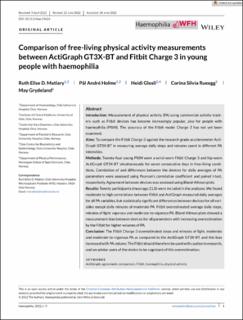| dc.contributor.author | Matlary, Ruth Elise Dybvik | |
| dc.contributor.author | Glosli, Heidi | |
| dc.contributor.author | Rueegg, Corina Silvia | |
| dc.contributor.author | Grydeland, May | |
| dc.contributor.author | Holme, Pål André | |
| dc.date.accessioned | 2022-09-14T07:21:26Z | |
| dc.date.available | 2022-09-14T07:21:26Z | |
| dc.date.created | 2022-08-01T11:09:17Z | |
| dc.date.issued | 2022 | |
| dc.identifier.citation | Haemophilia. 2022, Artikkel 14624. | en_US |
| dc.identifier.issn | 1351-8216 | |
| dc.identifier.uri | https://hdl.handle.net/11250/3017679 | |
| dc.description | This is an open access article under the terms of the Creative Commons Attribution-NonCommercial-NoDerivs License, which permits use and distribution in any medium, provided the original work is properly cited, the use is non-commercial and no modifications or adaptations are made. | en_US |
| dc.description.abstract | Introduction: Measurement of physical activity (PA) using commercial activity trackers such as Fitbit devices has become increasingly popular, also for people with haemophilia (PWH). The accuracy of the Fitbit model Charge 3 has not yet been examined.
Aims: To compare the Fitbit Charge 3 against the research-grade accelerometer ActiGraph GT3X-BT in measuring average daily steps and minutes spent in different PA intensities.
Methods: Twenty-four young PWH wore a wrist-worn Fitbit Charge 3 and hip-worn ActiGraph GT3X-BT simultaneously for seven consecutive days in free-living conditions. Correlation of and differences between the devices for daily averages of PA parameters were assessed using Pearson's correlation coefficient and paired t-test, respectively. Agreement between devices was assessed using Bland-Altman plots.
Results: Twenty participants (mean age 21.8) were included in the analyses. We found moderate to high correlations between Fitbit and ActiGraph measured daily averages for all PA variables, but statistically significant differences between devices for all variables except daily minutes of moderate PA. Fitbit overestimated average daily steps, minutes of light, vigorous and moderate-to-vigorous PA. Bland-Altman plots showed a measurement bias between devices for all parameters with increasing overestimation by the Fitbit for higher volumes of PA.
Conclusion: The Fitbit Charge 3 overestimated steps and minutes of light, moderate and moderate-to-vigorous PA as compared to the ActiGraph GT3X-BT, and this bias increased with PA volume. The Fitbit should therefore be used with caution in research, and we advise users of the device to be cognizant of this overestimation. | en_US |
| dc.language.iso | eng | en_US |
| dc.subject | ActiGraph | en_US |
| dc.subject | agreement | en_US |
| dc.subject | comparison | en_US |
| dc.subject | Fitbit | en_US |
| dc.subject | haemophilia | en_US |
| dc.subject | physical activity | en_US |
| dc.title | Comparison of free-living physical activity measurements between ActiGraph GT3X-BT and Fitbit Charge 3 in young people with haemophilia | en_US |
| dc.type | Peer reviewed | en_US |
| dc.type | Journal article | en_US |
| dc.description.version | publishedVersion | en_US |
| dc.rights.holder | © 2022 The Authors | en_US |
| dc.source.pagenumber | 9 | en_US |
| dc.source.journal | Haemophilia | en_US |
| dc.identifier.doi | 10.1111/hae.14624 | |
| dc.identifier.cristin | 2040278 | |
| dc.description.localcode | Institutt for fysisk prestasjonsevne / Department of Physical Performance | en_US |
| dc.source.articlenumber | 14624 | en_US |
| cristin.ispublished | true | |
| cristin.fulltext | original | |
| cristin.qualitycode | 1 | |
